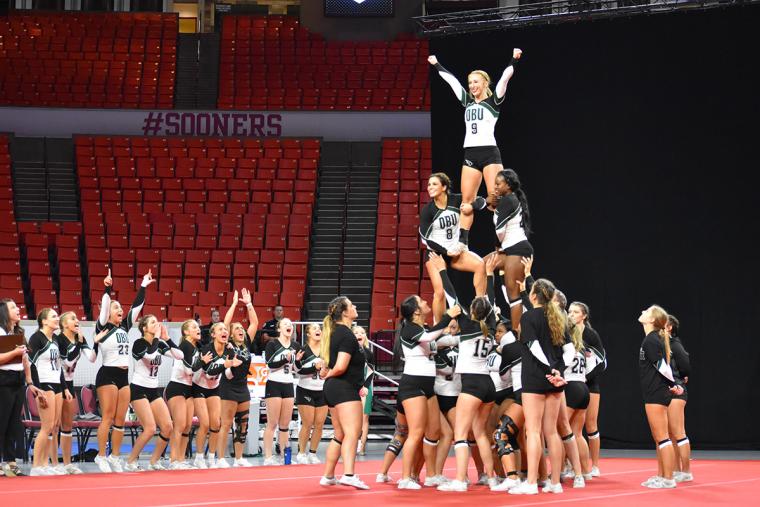

USA Cheer has three primary objectives: help grow and develop interest and participation in cheer throughout the United States; promote safety and safety education for cheer in the United States; and represent the United States of America in international cheer competitions.
In the spring of 2018, USA Cheer combined forces with the American Association of Cheerleading Coaches and Administrators (AACCA), which was founded in 1987 to address the safety concerns of the rapidly evolving cheerleading community and has been instrumental in the development of cheerleading safety regulations, coaches’ education and risk management.
This development, new since the last time SDM touched base with AACCA and USA Cheer, allows the sport’s leadership to continue developing new and improved strategies for keeping athletes safe while allowing cheer to continue evolving.
What’s New at USA Cheer?
Last year, for the first time ever, we offered a cheer combine. This event allowed cheerleaders to showcase their skills to prospective college coaches. In September 2018, we hosted two combines in California. They were a huge success, with over 400 high school cheerleaders, plus coaches from various colleges. As a result, we had a lot of requests to host more combines, especially now that there is such a growing awareness of STUNT and all that it offers.

This year, we’ve already scheduled five combines; they will be held at Dallas Baptist University (Texas) on August 3; Concordia Irvine University (California) on September 14; Sacramento State University (California) on September 15; Ashland University (Ohio) on September 22; and Oral Roberts University (Oklahoma) on September 29. We may be adding some locations in the Northeast and in the Southeast as well.
Previously, there hadn’t been a lot of ways for cheer athletes to connect directly and easily with college coaches, apart from traveling to specific colleges, sending videos to coaches or competing in events where coaches were likely to be. We believe that as we continue to host cheer combines, coaches will recognize them as the place to look for up-and-coming athletes.
We’re also encouraging athletes, coaches, schools and all-star programs to begin working with CaptainU, which is a platform allowing athletes to market themselves to coaches and college programs. Overall, at USA Cheer, we’re focused on helping athletes expand their reach and find the right fit when it comes to continuing on in their cheer or STUNT career.
What’s New with STUNT?
This is our ninth year of offering college STUNT, which just continues to grow. Our 2019 College STUNT National Championship was held in the Lloyd Noble Center on the campus of the University of Oklahoma in Norman, Oklahoma, in early May. Oklahoma State University defeated Michigan State University in the Open Division I Finals. Davenport University beat Alma College in the Open Division II/III Finals.
 The Davenport University Panthers ultimately took top honors over Oklahoma State University in the final bracket where the top Varsity teams from each division competed for title of Varsity Division National Champion. It was incredibly exciting, and the competition went right down to the wire in overtime.
The Davenport University Panthers ultimately took top honors over Oklahoma State University in the final bracket where the top Varsity teams from each division competed for title of Varsity Division National Champion. It was incredibly exciting, and the competition went right down to the wire in overtime.
In choosing a location for the championships, it was important to us to be in an area where STUNT was prevalent. The USA Cheer website has a section on STUNT, and you’ll find separate pages listing the colleges that are currently offering STUNT, as well as the states where there is high school activity.
STUNT is engaging, easy to understand and fun for spectators. It uses many of the traditional elements of cheer (jumps, tumbling, pyramids and partner stunts) but it is very fast paced, with four quarters of action and each game taking approximately one hour. Both teams are always on the floor head to head and results are displayed immediately, which makes it very different from a traditional cheer competition, in which each squad performs its own routine individually before winners are announced. If you haven’t seen STUNT, you can find plenty of videos of games online. One other unique thing about STUNT is that it’s a controlled environment; there isn’t pressure to build a customized or original routine and learn that in time for new competitions. The routines are determined ahead of time so every team is doing the exact same skill and the one who executes it the best, wins! This increases the precision that teams use and overall safety since the reward is on execution.
We expect to see STUNT continue to spread in popularity. We have had many new colleges who came on board over the last year with many more for the 2020 season. In addition, we are launching YOUTH STUNT and we already have a huge interest in youth programs across the U.S. indicating their desire to start. That’s not really surprising; youth and high school athletes have always wanted to emulate what they see at the collegiate level. In fact, during our nationals in Oklahoma, a YOUTH STUNT team came in and performed. It was great for them to be able to see what was going on and what they could aspire to and I also think it was good for the college athletes to see the way their performance affects the younger generation.

Since 2011, more than 100 colleges have participated in STUNT, and along with more than 200 high schools from nine states, they are making STUNT the fastest growing female sport in the country. It was developed to meet the requirements of a sport under Title IX. Currently, we have 17 colleges that are offering STUNT as a varsity sport and over 22 additional club programs. We expect to see an increasing number of colleges take part in this, and we believe our cheer combines also will be very valuable in allowing athletes with the right skills to connect with schools that have active STUNT teams.
Will We See Cheer in the Olympics?
In late 2016, cheer received provisional recognition from the IOC but a lot needs to happen before any sport can appear at the Games. We were honored to be able to send a squad to perform at the 2018 Olympics in PyeongChang. It came about when the host country, South Korea, chose to bring in the cheer teams from the top seven countries in medal count from the last Winter Olympics as global supporters. It was funded by South Korea and we were thrilled to be a part of it. Currently, there are no plans for cheer in Tokyo in 2020.
Cheer continues to get international attention, however. The Olympic Channel covered the International Cheer Union (ICU) World Championships that took place in April so of course, that results in even more publicity for the sport and more excitement. The sport is growing at all levels and among all age groups.
…And It’s Staying Safe
The sport has definitely changed since the 1970s when we were seeing some crazy skills that involved kids building incredibly high pyramids and flipping onto them by using the trampoline. We’ve dialed it back to make it as safe as possible, while at the same time keeping the creativity a lot of kids want. One of the things we do is keep stats on injuries each year, which allows us to see the areas where we need to expand upon existing rules or create new restrictions.
USA Cheer has announced its updated Middle School, Junior High and High School Cheer Rules, and its new USA Cheer Safety Course and first ever rules course. We recommend all coaches to complete the safety course every four years because we want to empower them to make good decisions that keep athletes safe. The rules course is new and we are excited to be able to help coaches understand the rules better than ever before as they go into their next season. We expect to release a rules/safety course for Youth Rec Cheer as well.
As a result, cheer remains safe and fun, while offering athletes the ability to challenge themselves. Nationwide in the U.S., there are approximately three million cheerleaders, including youth, high school, college and all-star programs. We’re excited about all the opportunities for our sport. SDM

